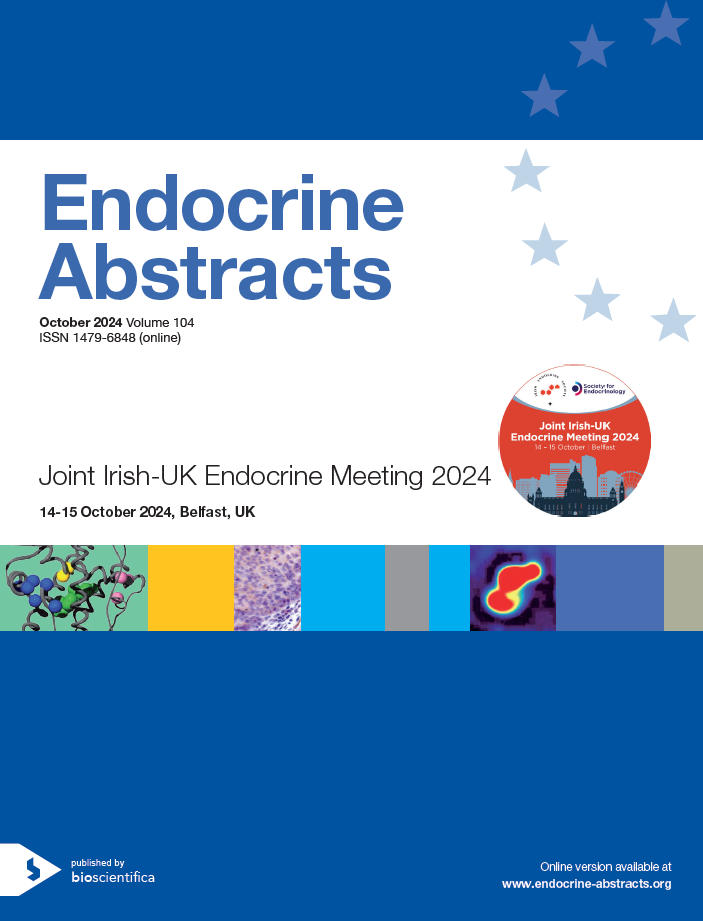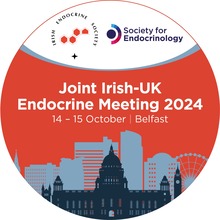
Joint Irish-UK Endocrine Meeting 2024
Belfast,
Northern Ireland
14 Oct 2024 - 15 Oct 2024

Poster Presentations
Neuroendocrinology
ea0104p138 | Neuroendocrinology | SFEIES24
Treatment resistant cushing’s disease following standard and novel multi-modal therapy in the setting of a constitutional pathogenic MSH2 variant
Armstrong Thomas , Loughrey Ben , Eatock Fiona , Lindsay John
ea0104p139 | Neuroendocrinology | SFEIES24
Progressive neurosarcoidosis presenting as idiopathic hypopituitarism with atypical radiological features for 13 years
Tahir Younas Muhammad , Dale Jane , Khan Maryam
ea0104p140 | Neuroendocrinology | SFEIES24
Screening for carcinoid heart disease (CaHD): an audit of practice and assessment of deprivation index in sheffield NET centre, a european neuroendocrine centre of excellence
Abdelhaleem Elsadig , Abdella Osama , Lin Kwok Wen , Harber James , EA Rowett Oliver , Munir Alia
ea0104p141 | Neuroendocrinology | SFEIES24
Efnb2 controls pituitary development by regulating the pituitary stem cell niche
Gualtieri Angelica , Gomez-Corral Laura , Nicholson James , Tan Rachael , Guasti Leonardo , Gaston-Massuet Carles
ea0104p142 | Neuroendocrinology | SFEIES24
Kisspeptin does not induce anxiety in humans
G. Mills Edouard , Thurston Layla , Yang Lisa , Suladze Sofiya , Hunjan Tia , Phylactou Maria , Patel Bijal , A. Clarke Sophie , J. Shah Amar , Izzi-Engbeaya Chioma , Tsoutsouki Jovanna , Young Megan , Bech Paul , Ertl Natalie , Demetriou Lysia , B. Wall Matthew , Goldmeier David , Abbara Ali , N. Comninos Alexander , S. Dhillo Waljit
ea0104p143 | Neuroendocrinology | SFEIES24
Clinical complexities of adipsic arginine vasopressin deficiency
Chaudhury Nadia , Kadavileveetil Mekha , Sheikh Abdur , Franklin Danielle , Gholap Nitin , Murthy Narasimha , Rao Ranganatha
ea0104p144 | Neuroendocrinology | SFEIES24
Case: recurrent vaginal paraganglioma with hypertension in pregnancy
Lonergan Eibhlin , Ng Nicholas , O'Shea Donal , Crowley Rachel K.
ea0104p145 | Neuroendocrinology | SFEIES24
Panhypopituitarism secondary to CVST with dominant posterior pituitary symptoms
ea0104p146 | Neuroendocrinology | SFEIES24
Transformation of non-functioning pancreatic neuroendocrine tumours into insulinomas in multiple endocrine neoplasia type 1: a case report
Maher Michelle , Crowley Rachel K. , Divilly Patrick , Maguire Donal , O'Shea Donal , O'Toole Dermot , Almeamar Hussein
ea0104p147 | Neuroendocrinology | SFEIES24
Assessing biological stress markers in the hair of individuals at ultra-high risk for psychosis using a novel method of extraction
Fensome Grace , Simmonds Livia , Wood Stephen , Hardy Rowan , Khanim Farhat , Shaheen Fozia , Taylor Angela , Reniers Renate
ea0104p148 | Neuroendocrinology | SFEIES24
Effect of endoscopic transsphenoidal surgery on pituitary function – preliminary report from a tertiary referral centre
Okiro Julie , Kyne Niamh , Ibrahim Ibrahim , AlBusaidy Merah , Fuller Raymond , Vaswani Aneel , Carthy Claire , O'Brien Donncha , Zilani Gulam , Javadpour Mohsen , Agha Amar
ea0104p149 | Neuroendocrinology | SFEIES24
A case report of an FSH-producing pituitary macroadenoma presenting with panhypopituitarism in a male
Comerford Saidhbh , Courtney Aoife , Phelan Niamh , Beausang Alan , Owens Lisa , Pazderska Agnieszka
ea0104p150 | Neuroendocrinology | SFEIES24
Ectopic adrenocorticotropic hormone secretion in metastatic small cell lung cancer
Bonanos Stathis , Kelly Rhys , Bhuinyan Asima , Kelly Martin , Black Neil , Thiraviaraj Athinyaa
ea0104p151 | Neuroendocrinology | SFEIES24
The pre- and perioperative management of pheochromocytomas and intraabdominal paragangliomas- service evaluation at the tertiary centre
Keavney Zack , Stechman Michael , Scott-Coombes David , Lansdown Andrew , Taylor Peter , Witczak Justyna
ea0104p152 | Neuroendocrinology | SFEIES24
A review of outcomes following outpatient alpha-adrenoceptor blockade preoperatively in patients with pheochromocytoma and paraganglioma in a single tertiary centre
Lonergan Eibhlin , Forde Sarah , Ludgate Stephen , Goulden Eirena , Hoti Emir , Prichard Ruth , Browne Ingrid , K. Crowley Rachel
ea0104p153 | Neuroendocrinology | SFEIES24
Pheochromocytoma and takotsubo cardiomyopathy: a case report
Aung Nwe , Al-Qaysi Amina , Ashraf Masood
ea0104p154 | Neuroendocrinology | SFEIES24
Primary hyperparathyroidism in multiple endocrine neoplasia type 1 (MEN1): the northern ireland (NI) experience
Ahmed Doua , Shahzad Muhammad A. , D'Arcy Robert , Graham Una M. , McHenry Claire M.
ea0104p155 | Neuroendocrinology | SFEIES24
Fertility outcomes following transsphenoidal surgery for pituitary tumours at the university hospital of wales, cardiff
Whiting Abbie , Lansdown Andrew , Mohamed Amr , Rees Aled , Hayhurst Caroline
ea0104p156 | Neuroendocrinology | SFEIES24
Using transcriptomics to refine the subtypes of non-functioning pituitary neuroendocrine tumours
Upritchard Michael , Benjamin Loughery Paul , Craig Stephanie G. , Cooke Stephen , Herron Brian , Miskelly Julia , Jayne McKnight Amy , James Jaqueline A.
ea0104p157 | Neuroendocrinology | SFEIES24
A case of panhypopituitarism due to a rathke’s cleft cyst in a 32-year-old male with autoimmune polyendocrinopathy-candidiasis-ectodermal dystrophy (APECED)
Bowers Kevin , Louise Healy Marie , Pazderska Agnieska
ea0104p158 | Neuroendocrinology | SFEIES24
Acute haemorrhagic stroke in a young patient: unusual presentation of cushing’s disease
Schiteanu Cosmina , Mukunda Athira , James Jovito , Vijay Arun , Ferdinand Phillip , Jose Biju
ea0104p159 | Neuroendocrinology | SFEIES24
Hiding in plain sight: pitfalls in the evaluation of cushing’s syndrome
Martin-Grace Julie , Carthy Claire , Tomkins Maria , McDonnell Tara , Costello Richard , O'Reilly Michael , Sherlock Mark
ea0104p160 | Neuroendocrinology | SFEIES24
An unusual presentation of macroprolactinoma
Bharadwaj Rakshith , Sehemby Manjeet , Ahmad Tariq , Buch Harit
ea0104p161 | Neuroendocrinology | SFEIES24
Challenges of treatment of metastatic insulinoma- case series
Apsara Dilrukshi Mathara Diddhenipothage Shani , Matheou Michael , Wilson Shaun , Moore Niall , May Christine J. H. , Jafar-Mohammadi Bahram
ea0104p162 | Neuroendocrinology | SFEIES24
Defining food intake and body fat accumulation in an MC4R zebrafish model
Jhosadara Espinosa Flores Aranza , Jackson David , Chan Li , Brennan Caroline
ea0104p163 | Neuroendocrinology | SFEIES24
A case of atypical presentation of macroprolactinoma in young female
Ahmad Tariq , Bharadwaj Rakshith , Buch Harit
ea0104p164 | Neuroendocrinology | SFEIES24
Multidisciplinary management of aggressive corticotroph pitnets. a case series
Radian Serban , Alexandru Niculescu Dan , Galoiu Simona , Stoleru Liviu , Preda-Ivascu Monalisa , Nuta Andreea , Iancu Cristina , Ciubotaru Vasile , Gobej Ionut , Cristescu Alexandru , Poiana Catalina
ea0104p165 | Neuroendocrinology | SFEIES24
A case series of insulin-mediated hypoglycaemia in older adults
Madden Doyle Lauren , Bowers Kevin , O'Toole Dermot , Healy Marie-Louise
ea0104p166 | Neuroendocrinology | SFEIES24
Physiological growth of the pituitary gland or hypophysitis - difficult differential diagnosis of pituitary enlargement in adolescence. report of two cases
ea0104p167 | Neuroendocrinology | SFEIES24
DNA methylation via nanopore sequencing: will it be the future biomarker of the neuroendocrine tumour?
Ahsan Masato , Gohil Shailesh , AlJumaah Ali , Reddy Narendra , Shaw Jacqui , Levy Miles



